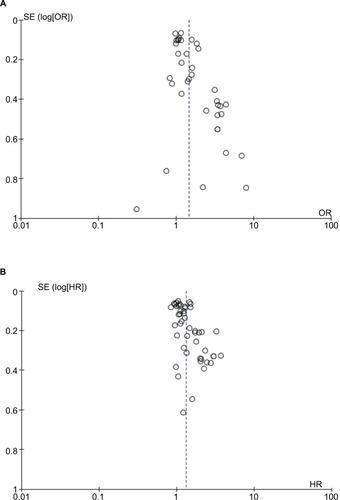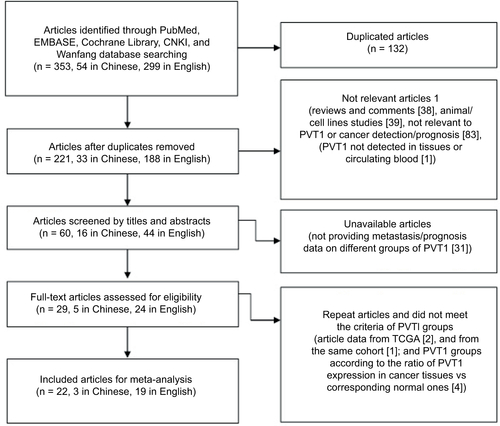Abstract
Purpose
Long noncoding RNA PVT1 is dysregulated in some human tumors and has been found to increase the risk of tumor progression and poor prognosis. This study aimed to reanalyze the effect of PVT1 on tumorous prognosis.
Materials and methods
The effect of PVT1 on metastasis and survival were analyzed by univariate logistic regression and Cox proportional hazards model for 32 types of cancer in the Cancer Genome Atlas database (TCGA), and the relationship between PVT1 level and expression of relative genes was assessed by Pearson correlation analysis. RevMan5.3 and STATA14.0 were used to estimate pooled effects of PVT1 on cancer prognosis with data from TCGA and published studies.
Results
In TCGA data, high PVT1 expression tended to increase the risk of TNM progression and decreased the overall survival (OS) time in most of cancers. The pooled effect of PVT1 on TNM (pooled-OR=1.46, 95% CI: 1.29–1.65) and OS (pooled HR=1.32, 95% CI: 1.22–1.43), calculated from 37 and 48 cohorts, identified that high PVT1 expression promoted the metastasis and poor prognosis of cancer. Furthermore, the pooled ORs of 2.77 (95% CI: 1.65–4.66), 4.32 (95% CI: 1.99–9.36), 1.35 (95% CI: 1.01–1.80), 1.62 (95% CI: 1.21–2.18) and 1.48 (95% CI: 1.02–2.15) provided evidence that PVT1 played a role in lymph node metastasis, depth of invasion, distant metastasis, differentiation and lymphatic invasion; while the expression of 24 identified target genes was significantly associated with PVT1 level, and high PVT1 expression dependently decreased the OS time under the influence of co-expression genes (OR=1.29, 95% CI: 1.25–1.32) in high-throughput RNA sequencing merging data. In addition, the expression of PVT1 could be upregulated by smoking, with the pooled OR being 1.09 (95% CI 1.01–1.16).
Conclusion
PVT1 is a dependent biomarker for tumorous prognosis surveillance. However, the reference value of PVT1 needs further study.
Keywords:
Introduction
Cancer is a major public health problem worldwide.Citation1 Although a decrease of overall cancer mortality has been observed in the last two decades,Citation2 it still causes 22% of noncommunicable disease deaths,Citation3 due to the complex pathogenesis and few target treatments. Numerous experimental studies have attempted to reveal the mechanisms of tumorigenesis to provide clues for prevention, early diagnosis and target treatment. Developments in biotechnology have gradually unveiled some of the mysteries of cancer, with the identification of abundant DNA biomarkers, transcripts, protein and epigenetics. Noncoding RNAs (ncRNAs), which are the largest component of human genome transcripts, especially long noncoding RNAs (lncRNAs), have been confirmed as participating in diverse cellular processes from normal development to cancer.Citation4 Increasing evidence suggests that lncRNAs could be the key regulators interacting with other components such as proteins, RNAs and DNAs;Citation5,Citation6 while regulating lncRNAs have been shown to have aberrant expression in tumor tissues.Citation7–Citation9 To date, overwhelming numbers of cancer-related lncRNAs have been reported in the database of the Cancer Genome Atlas (TCGA) projectCitation10,Citation11 as well as the noncode database (http://www.noncode.org) and LNCipedia (http://www.lncipedia.org). Because of being involved in the onset and development of cancer, some key lncRNAs are expected to play a crucial role in cancer detection, diagnosis and therapy.
lncRNA PVT1, homologous to the mouse plasmacytoma variant translocation gene (Pvt1), lies in human chromosome 8q24.21 and has attracted widespread attention.Citation12 Recent studies showed that PVT1 was dysregulated in some human tumors, such as gastric cancer, nonsmall-cell lung cancer, colorectal cancer, esophageal cancer, pancreatic cancer, and hepatocellular carcinoma.Citation10,Citation13,Citation14 High PVT1 expression was further found to increase the risk of tumor progression and poor prognosis.Citation13,Citation15–Citation17 Furthermore, studies of its mechanism suggested that aberrant level of PVT1 was linked to proliferation, angiogenesis and metastasis in human malignancies.Citation18,Citation19 PVT1 might act as an effective biomarker for tumorous prognosis surveillance. Nevertheless, the association between PVT1 expression and cancer prognosis is still not clear. Moreover, no meta-analysis has investigated the common effect of PVT1 on prognosis of most cancers based on multisource data.
The present study aimed to analyze the pooled effect of PVT1 on cancer prognosis by meta-analysis and further explore possibly common target genes of PVT1 in most cancers.
Materials and methods
TCGA sequencing data
High-throughput RNA sequencing (RNA-Seq) and clinical data of different cancers were downloaded from https://portal.gdc.cancer.gov/projects/(TCGA database). Because it did not show in RNA-Seq data of most cancers, PVT1 expression level was redownloaded from https://xenabrowser.net/heatmap/(TCGA database). All the expression data were transformed into the format of log2 (Illumina Hiseq Pancan normalized numbers+1) after deleting the samples with no PVT1 data or where PVT1 was detected in corresponding normal tissues. Only the samples with clinical and PVT1 expression data were further enrolled for prognosis analysis.
Literature search strategy
English or Chinese studies on the role of PVT1 in human cancer were searched in PubMed, EMBASE, Cochrane Library, China National Knowledge Infrastructure, and Wanfang databases with the keywords PVT1 and cancer. The references of retrieved papers and conference reports were also searched to identify relevant studies. The last search date was May 8, 2017.
Selection criteria of reported research
The titles and abstracts of searched articles were checked by 4 authors (YC, CW, ZS, and DW) after duplicates were removed. Then, the full text of eligible articles was retrieved. Eligible articles should have the following criteria: 1) the expression of PVT1 was analyzed by prognosis of human cancer; 2) the expression of PVT1 was detected in cancer tissue or circulating blood by reverse transcription polymerase chain reaction (RT-PCR), fluorescence in-situ hybridization or RNA-Seq; 3) the high and low groups of PVT1 expression were divided by the mean/median or ROC curve; and 4) HRs for survival (overall survival [OS], recurrence-free survival [RFS], disease-free survival [DFS], and progression-free survival [PFS]) or ORs for metastasis (tumor-node-metastasis [TNM], lymphatic invasion [LI], lymph node metastasis [LNM], depth of invasion [DOI], distant metastasis [DM], and differentiation [DIF]) were provided or could be calculated from the available data. Furthermore, if more than 1 report from the same cohort was published, only the most recent publication was included. Consensus in searching and exclusion was resolved by discussion of 3 other investigators (XC, YZ, and DH) if needed.
Data extraction and quality assessment
Four authors (YY, SW, HJ, and GZ) extracted the following data by an extraction form: first author’s name, published year, region of cohort, cancer type, sample size, and HRs/ORs (95% CI). The quality of studies was assessed by New-castle–Ottawa Scale (NOS) and the score ≥ 6 was considered as high quality.
Statistical methods
Univariate logistic regression was applied to analyze the risk of high PVT1 expression on metastasis as well as the effect of smoking on PVT1 expression, whereas the PVT1 effects on OS of 32 types of cancer were assessed by the Cox proportional hazards model with TCGA data. In the meta-analysis, the heterogeneity among studies was tested by inconsistency (I2) and Q tests (chi-square test). The fixed effects model was used to estimate the pooled effect with no statistical heterogeneity found (I2<50%, PQ>0.05); otherwise, a random effects model was used. Publication bias was assessed by Begg’s and Egger’s tests, as trim and fill analysis was used to adjust the pooled effects, if necessary.Citation20 In addition, Engauge Digitizer 4.1 was used to analyze HRs and 95% CIs, when they were not provided directly in some studies. The correlations between PVT1 and other genes were estimated by Pearson correlation analysis. All tests, being considered statistically significant with P<0.05, were two sided and performed by STATA 14.0 and Review Manager 5.3 (Cochrane network).
Results
The effect of PVT1 on prognosis of TCGA cancers
The 9,451 patients with 32 types of cancer were divided into high and low groups with the cutoff point being the median of the PVT1 level which was stably detected in tissues. As shown in , high PVT1 expression tended to deteriorate the prognosis of most cancers. Furthermore, it significantly increased the risk of TNM progression of breast cancer, head and neck cancer, kidney clear cell carcinoma (KIRC), and kidney papillary cell carcinoma (KIRP), with ORs being 1.168 (P=0.022), 1.947 (P<0.001), 1.593 (P<0.001) and 1.841 (P<0.001), and significantly decreased the OS time of adrenocortical cancer, KIRC, lower grade glioma, pancreatic cancer, prostate cancer, sarcoma, thyroid cancer, endometrioid cancer, and ocular melanomas (UVM) with the HRs being 1.953 (P=0.001), 1.508 (P<0.001), 1.519 (P<0.001), 1.292 (P=0.002), 2.010 (P=0.041), 1.235 (P=0.043), 1.741 (P=0.006), 2.329 (P=0.005), 1.471 (P<0.001), and 3.718 (P<0.001). Conversely, the OS time of stomach cancer was significantly increased with high PVT1 expression (HR=0.848, P=0.046). In addition, smoking significantly increased the expression of PVT1 in KIRP (OR=1.319, P=0.007) and lung adenocarcinoma (OR=1.205, P=0.034).
Table 1 The effect of PVT1 on TNM and survival as well as smoking on PVT1 expression
Published studies of PVT1 on tumorous prognosis
The literature search resulted in 22 published studies eligible for the meta-analysis (Figure S1), 19 from China,Citation13,Citation15,Citation16,Citation18,Citation19,Citation21–Citation34 and 3 from Japan,Citation35 USA,Citation17 and Italy.Citation36 These studies involved 2,376 patients and 11 types of cancers, whose PVT1 level was detected in tumor tissue and circulating blood by RT-PCR. The main characteristics of each study are summarized in . In addition, the included studies had high quality, with NOS scores of more than 6 for each study (data not shown).
Pooled effect of PVT1 on tumorous prognosis
Pooled effect of PVT1 on progression
Seventeen cohorts from published studies and 20 from TCGA provided the ORs of PVT1 on TNM progression in 8,128 patients. Under the random effects model, the pooled effect (pooled OR=1.46, 95% CI: 1.29–1.65) showed that high PVT1 significantly increased the risk of TNM progression (, Figure S2). Moreover, high PVT1 expression also significantly promoted the development of LNM, DOI and DM with pooled ORs of 2.77 (95% CI: 1.65–4.66), 4.32 (95% CI: 1.99–9.36) and 1.35 (95% CI: 1.01–1.80) under the random effects model (, Figure S3A–C). Furthermore, the risks of poor differentiation (pooled OR=1.62, 95% CI: 1.21–2.18) and lymphatic invasion (pooled OR=1.48, 95% CI: 1.02–2.15) were significantly increased in patients with high PVT1 expression under the fixed effects model (, Figure S3D–E).
Table 2 The effect of high PVT1 expression on metastasis
Pooled effect of PVT1 on survival
Forty-eight cohorts, 16 from published studies and 32 from TCGA, showed data for OS by PVT1 level in 11,022 patients. The pooled effect (pooled HR=1.32, 95% CI: 1.22–1.43) indicated that high PVT1 expression significantly decreased the OS time under the random effects model (, Figure S4). Similar effects have been shown on DFS (pooled HR=1.77, 95% CI: 1.46–2.13) and PFS (pooled HR=1.71, 95% CI: 1.45–2.00) which were reported in more than 2 cohorts (, Figure S5).
Table 3 The effect of high PVT1 expression on prognosis
Pooled effect of smoking on PVT1 expression
In addition, the effects of smoking on PVT1 expression were also reported in 12 cohorts within 3,600 patients. depicts that smoking significantly increased the level of PVT1 expression under the fixed effect model (pooled OR=1.09, 95% CI: 1.01–1.16).
Figure 1 Pooled OR of smoking on PVT1 expression.
Abbreviations: SE, standard error; IV, inverse variance methods; BLCA, bladder cancer; CESC, cervical cancer; ESCA, esophageal cancer; HNSC, head and neck cancer; KICH, kidney chromophobe; KIRC, kidney clear cell carcinoma; KIRP, kidney papillary cell carcinoma; LUAD, lung adenocarcinoma; LUSC, lung squamous cell carcinoma; PAAD, pancreatic cancer; TCGA, the Cancer Genome Atlas database.
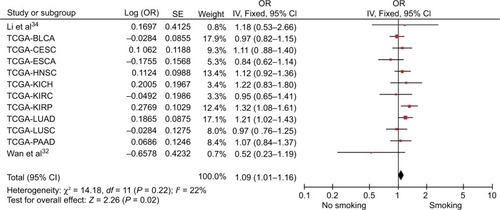
Correlation of PVT1 and relative genes in TCGA cancers
Thirty-four relative genes of PVT1 in cancers were summarized by systematic review. Besides 6 co-expression genes in 8q24, 28 target genes of transcriptional regulation of PVT1 were identified by functional experiments in a variety of human cell lines.Citation30–Citation33,Citation35,Citation37–Citation50 The correlations between them and PVT1 were assessed with the merging RNA-Seq data of 32 types of cancers in TCGA. The PVT1 level was positive relative to the expression of 30 genes except for miR-30a (r=0.0196, P=0.06384), whereas miR-1206, miR-146a and miR-195 could not be detected by RNA-Seq technique (). However, the relative coefficient of miR-152 (r=0.0382, P=0.00031) and TSHR (r=0.0897, P<0.00001) was <0.1, which was considered as no correlation. Because of significant correlations between PVT1 and co-expression genes, the effects of PVT1 on OS time were further assessed by Cox proportional hazards model by controlling the expression of MYC, miR-1207, miR-1208, miR-1205, miR-1205 and miR-1204 in 9451 patients of 32 types of cancer; as shown in , high PVT1 expression still decreased the OS time with the HR being 1.29 (95% CI: 1.25–1.32).
Table 4 The characteristic of identified genes and correlation with PVT1 in 8,927 patients of 32 cancers
Table 5 The effect of PVT1 and coexpression genes on OS time under Cox proportional hazards model
Sensitivity analysis
Sensitivity analysis was conducted for the association between PVT1 expression and TNM as well as OS. Each diagnosis test was deleted in turn to examine the influence of the removed data on the overall OR/HR. High PVT1 expression still significantly increased the risk of TNM and OS throughout (data not shown).
Publication bias
Publication bias was checked for the effects of PVT1 expression on TNM and OS (). Begg’s test showed significant rank correlation in studies of PVT1 effect on TNM (Z=2.45, Pr> |z|=0.015) and OS (Z=3.01, Pr>|z|=0.003). Given this result, we performed Egger’s test where evidence of significance publication bias was found for TNM (r=1.81, 95% CI: 0.98–2.64, P<0.0001) and OS (r=1.85, 95% CI: 0.95–2.74, P<0.0001). Consequently, we performed trim and fill analysis; the adjusted pooled-OR of TNM and pooled-HR of OS were 1.31 (95% CI: 1.16–1.49) and 1.15 (95% CI: 1.11–1.18) with P<0.0001 for heterogeneity of both.
Discussion
This study aimed to assess the effect of PVT1 expression on cancer prognosis. The pooled effect showed that high PVT1 expression significantly increased the risk of poor differentiation and cancer metastasis, and significantly decreased the survival time of patients. Furthermore, the expression of PVT1 was significantly correlated to that of genes playing important roles in tumorigenesis. PVT1 could act as an effective biomarker for tumorous prognosis surveillance.
lncRNAs have been shown to act as master regulators of gene expression and thus could play a critical role in various biological functions and disease processes including cancer. With the advances in the RNA-Seq technique and improvement of bioinformatics, a large number of tumor associated lncRNAs have recently been discovered through genomics studies. However, only a few lncRNAs have been fully explored to understand the role in cancers such as regulation of transcription, translation, protein modification and the formation of RNA–protein or protein–protein complexes. PVT1 has been identified as an oncogene and highly correlated with Myc which participates in oncogene activation through Akt/c-Myc signaling pathway.Citation12,Citation13,Citation51,Citation52 Further research into the mechanism found PVT1 could target genes such as LASP1, p15, p16, EZH2, TSHR, and FOXM1 to promote tumor cell proliferation, migration and invasive capability in some cancers.Citation25,Citation28,Citation34,Citation48 Moreover, PVT1 was confirmed to promote protein stability of MYC, RSPO1, NOP2 and increase the level of them.Citation52–Citation54 High PVT1 expression was also linked to poor prognosis of some cancers with most patients from China (). The relationship between PVT1 expression and cancer prognosis is still ambiguous and should be identified by more samples from other groups. For stable detection in 32 types of TCGA cancer, it was found that PVT1 tended to increase the risk of TNM progression and decrease the OS time in most of them.
To further explore the unbiased effect of PVT1 on cancer prognosis, we performed a meta-analysis with the cohorts from TCGA and other published studies. The adjusted pooled OR of 1.31 (95% CI: 1.16–1.49) and pooled HR of 1.15 (95% CI: 1.11–1.18) indicated that high PVT1 increased the risk of TNM progression and decreased the overall survival time. The effect of high PVT1 on depth of invasive, lymph node metastasis, distant metastasis as well as poor differentiation and lymphatic invasion also provided direct and epidemiological evidence of PVT1 participating in cancer metastasis. Furthermore, five co-expression genes and 24 identified target genes were significantly associated with PVT1 in all TCGA cancers; although the relative coefficients of them were too small to declare a high degree of correlation, which might be caused by heterogeneity of huge samples of data. Moreover, high PVT1 expression dependently decreased the OS time of patients by controlling the influence of co-expressed genes. In addition, it was shown that the expression of PVT1 could be upregulated by smoking to deteriorate the cancer prognosis.Citation55–Citation57 This suggested that PVT1 expression was an effectively common biomarker for human tumorous prognosis surveillance.
Some meta-analyses focused on the association between lncRNAs such as BANCR,Citation58 HOTTIP,Citation59 CCAT2,Citation60 and metastasis as well as prognosis of cancer; all based on lncRNAs detected by RT-PCR from the cohorts of published studies. To search for an applicably common biomarker for prognosis surveillance, we focused on the effect of PVT1 expression, detected by RT-PCR and RNA-Seq on metastasis and survival as well as the correlation of PVT1 and possible target genes in all common cancer. In the present study, a new way was provided to improve the traditional meta-analysis, by which useful information not published in the literature could be found through published databases to provide more comprehensive evidence. More importantly, the possible mechanism and the common effect of PVT1 on prognosis of all cancers was proved. Furthermore, we provide coefficient references for correlation analysis of gene expression with huge amounts of RNA-Seq data. To our best knowledge, this is the first improved meta-analysis of PVT1 effect on cancer prognosis with the data from the cohorts of TCGA and published studies.
Our study also contains some limitations. Since PVT1 was identified as a common biomarker for cancer prognosis surveillance, there was no reference value to distinguish poor prognosis patients with PVT1 expression detected by RT-PCR or RNA-Seq. Second, although 24 possible target genes were proved to be significantly related to PVT1 expression in most cancers by pooled analysis, the mechanism of their involvement in PVT1 deteriorating cancer prognosis was still clear. Therefore, studies are needed to explore the reference value of PVT1 expression detected by RT-PCR/RNA-Seq to distinguish poor prognosis as well as the role of PVT1 target genes in cancer prognosis.
Conclusion
This improved meta-analysis is the first to demonstrate the effect and possible mechanism of PVT1 on cancer prognosis. The expression of PVT1 could be a biomarker for tumorous prognosis surveillance.
Acknowledgments
The authors are grateful for the contribution of TCGA. This study was supported by Research Project of Shenzhen Health and Family Planning System (201604130086, SZBC2017003).
Supplementary materials
Figure S2 The pooled effect value of PVT1 on TNM.
Abbreviations: IV, inverse variance methods; SE, standard error; UVM, ocular melanoma; SKCM, melanoma; STAD, stomach cancer; TGCT, testicular cancer; THCA, thyroid cancer; READ, rectal cancer; LUSC, lung squamous cell carcinoma; MESO, mesothelioma; LIHC, liver cancer; LUAD, lung adenocarcinoma; LUSC, lung squamous cell carcinoma; KICH, kidney chromophobe; KIRC, kidney clear cell carcinoma; KIRP, kidney papillary cell carcinoma; HNSC, head and neck cancer; ESCA, esophageal cancer; ACC, adrenocortical cancer; BLCA, bladder cancer; BRCA, breast cancer; CHOL, bile duct cancer; TCGA, the Cancer Genome Atlas database.
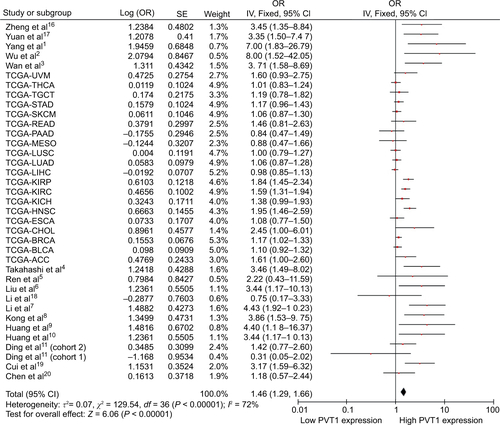
Figure S3 The pooled effect value of PVT1 on (A) LNM, (B) DOI, (C) DM, (D) DIF, and (E) LI.
Abbreviations: DIF, differentiation; DM, distant metastasis; DOI, depth of invasive; IV, inverse variance methods; LI, lymphatic invasion; LNM, lymph node metastasis; SE, standard error.
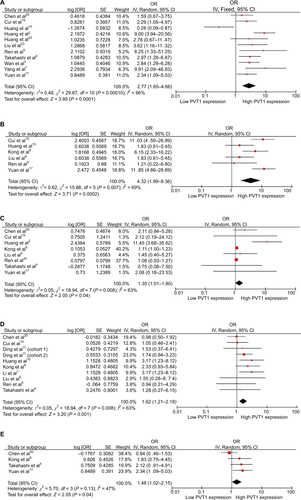
Figure S4 The pooled effect value of PVT1 on OS.
Abbreviations: IV, inverse variance methods; OS, overall survival; SE, standard error; ACC, adrenocortical cancer; BLCA, bladder cancer; BRCA, breast cancer; CESC, cervical cancer; CHOL, bile duct cancer; COAD, colon cancer; DLBC, large B-cell lymphoma; ESCA, esophageal cancer; GBM, glioblastoma; HNSC, head and neck cancer; KICH, kidney chromophobe; KIRC, kidney clear cell carcinoma; KIRP, kidney papillary cell carcinoma; LGG, lower grade glioma; LIHC, liver cancer; LUAD, lung adenocarcinoma; LUSC, lung squamous cell carcinoma; MESO, mesothelioma; OV, ovarian cancer; PAAD, pancreatic cancer; PCPG, pheochromocytoma & paraganglioma; PRAD, prostate cancer; READ, rectal cancer; SARC, sarcoma; SKCM, melanoma; STAD, stomach cancer; TGCT, testicular cancer; THCA, thyroid cancer; THYM, thymoma; UCEC, endometrioid cancer; UCS, uterine carcinosarcoma; UVM, ocular melanoma.
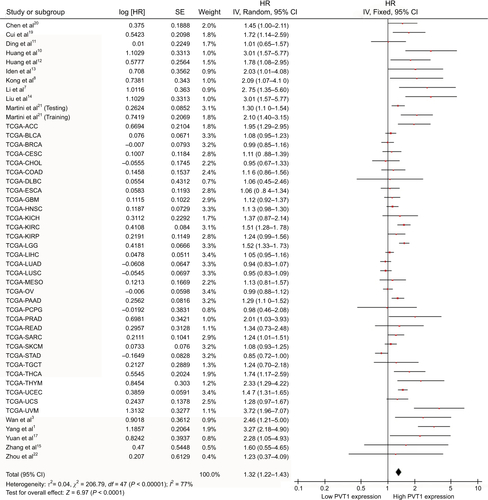
Figure S5 The pooled effect value of PVT1 on (A) DFS and (B) PFS.
Abbreviations: DFS, disease-free survival; IV, inverse variance methods; PFS, progression-free survival; SE, standard error.
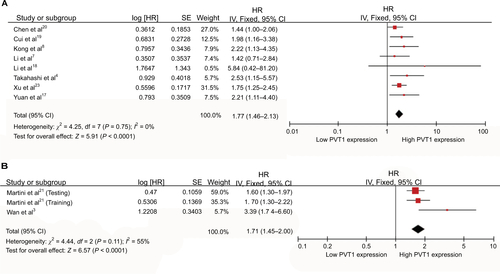
Table S1 Basic data for all included studies in the meta-analysis
References
- YangYRZangSZZhongCLLiYXZhaoSSFengXJIncreased expression of the lncRNA PVT1 promotes tumorigenesis in non-small cell lung cancerInt J Clin Exp Pathol20147106929693525400777
- WuBQJiangYZhuFSunDLHeXZLong noncoding RNA PVT1 promotes EMT and cell proliferation and migration through downregulating p21 in pancreatic cancer cellsTechnol Cancer Res Treat2017 1533034617700559
- WanLSunMLiuGJLong noncoding RNA PVT1 promotes non-small cell lung cancer cell proliferation through epigenetically regulating LATS2 expressionMol Cancer Ther20161551082109426908628
- TakahashiYSawadaGKurashigeJAmplification of PVT-1 is involved in poor prognosis via apoptosis inhibition in colorectal cancersBr J Cancer2014110116417124196785
- RenXXiaoYZhangLExpression and clinical significance of PVT1 gene in blood of the patients with gastric cancerChin J Cancer Biother20162305688691
- LiuYQuanXQinXYLEffect of neoadjuvant chemotherapy on difference of expression of IncRNA in ovarian cancer patientsPract J Cancer20163103384386+389
- LiPDHuJLMaCUpregulation of the long non-coding RNA PVT1 promotes esophageal squamous cell carcinoma progression by acting as a molecular sponge of miR-203 and LASP1Oncotarget2017821341643417628404954
- KongRZhangEBYinDDLong noncoding RNA PVT1 indicates a poor prognosis of gastric cancer and promotes cell proliferation through epigenetically regulating p15 and p16Mol Cancer2015148225890171
- HuangYMuZLinLExpression and clinical significance of lncRNA PVT1 in renal carcinoma tissuesShandong Medical201555361113
- HuangCYuWWangQIncreased expression of the lncRNA PVT1 is associated with poor prognosis in pancreatic cancer patientsMinerva Med2015106314314925668599
- DingCYangZLvZLong non-coding RNA PVT1 is associated with tumor progression and predicts recurrence in hepatocellular carcinoma patientsOncol Lett20159295596325624916
- HuangCLiuSWangHZhangZYangQGaoFLncRNA PVT1 overexpression is a poor prognostic biomarker and regulates migration and invasion in small cell lung cancerAm J Transl Res20168115025503427904703
- IdenMFyeSLiKChowdhuryTRamchandranRRaderJSThe lncRNA PVT1 contributes to the cervical cancer phenotype and associates with poor patient prognosisPLoS One2016115e015627427232880
- LiuYQuanXQinXYLEffect of neoadjuvant chemotherapy on difference of expression of IncRNA in ovarian cancer patientsPract J Cancer20163103384386+389
- ZhangSZhangGLiuJLong noncoding RNA PVT1 promotes cervical cancer progression through epigenetically silencing miR-200bAPMIS2016124864965827272214
- ZhengXHuHLiSHigh expression of lncRNA PVT1 promotes invasion by inducing epithelial-to-mesenchymal transition in esophageal cancerOncol Lett20161242357236227698800
- YuanCLLiHZhuLLiuZZhouJShuYAberrant expression of long noncoding RNA PVT1 and its diagnostic and prognostic significance in patients with gastric cancerNeoplasma201663344244926925791
- LiQDaiYWangFDifferentially expressed long non-coding RNAs and the prognostic potential in colorectal cancerNeoplasma201663697798327596298
- CuiDYuCHLiuMXiaQQZhangYFJiangWLLong non-coding RNA PVT1 as a novel biomarker for diagnosis and prognosis of non-small cell lung cancerTumour Biol20163734127413426490983
- ChenJLiYZhengQCircular RNA profile identifies circPVT1 as a proliferative factor and prognostic marker in gastric cancerCancer Lett201738820821927986464
- MartiniPParacchiniLCarattiGlncRNAs as novel indicators of patients’ prognosis in stage I epithelial ovarian cancer: a retrospective and multicentric studyClin Cancer Res20172392356236627827314
- ZhouQChenFZhaoJLong non-coding RNA PVT1 promotes osteosarcoma development by acting as a molecular sponge to regulate miR-195Oncotarget2016750826208263327813492
- XuMDWangYWengWA positive feedback loop of lncRNAPVT1 and FOXM1 facilitates gastric cancer growth and invasionClin Cancer Res20172382071208027756785
Disclosure
The authors report no conflicts of interest in this work.
References
- GBD 2015 Mortality and Causes of Death CollaboratorsGlobal, regional, and national life expectancy, all-cause mortality, and cause-specific mortality for 249 causes of death, 1980–2015: a systematic analysis for the Global Burden of Disease Study 2015Lancet2016388100531459154427733281
- HashimDBoffettaPLa VecchiaCThe global decrease in cancer mortality: trends and disparitiesAnn Oncol201627592693326802157
- PinerosMZnaorAMeryLBrayFA global cancer surveillance framework within noncommunicable disease surveillance: making the case for population-based cancer registriesEpidemiol Rev201739116116928472440
- PengWXKoiralaPMoYYLncRNA-mediated regulation of cell signaling in cancerOncogene201736415661566728604750
- SchmitzSUGrotePHerrmannBGMechanisms of long noncoding RNA function in development and diseaseCell Mol Life Sci201673132491250927007508
- GuttmanMRinnJLModular regulatory principles of large non-coding RNAsNature2012482738533934622337053
- DhamijaSDiederichsSFrom junk to master regulators of invasion: lncRNA functions in migration, EMT and metastasisInt J Cancer2016139226928026875870
- YuXLiZLong non-coding RNA HOTAIR: a novel oncogene (review)Mol Med Rep20151245611561826238267
- RavehEMatoukIJGilonMHochbergAThe H19 Long non-coding RNA in cancer initiation, progression and metastasis – a proposed unifying theoryMol Cancer20151418426536864
- WeidleUHBirzeleFKollmorgenGRügerRLong non-coding RNAs and their role in metastasisCancer Genomics Proteomics201714314316028446530
- LeeJSExploring cancer genomic data from the cancer genome atlas projectBMB Rep2016491160761127530686
- ColomboTFarinaLMacinoGPaci PVT1: a rising star among oncogenic long noncoding RNAsBiomed Res Int2015201530420825883951
- CuiDYuCHLiuMXiaQQZhangYFJiangWLLong non-coding RNA PVT1 as a novel biomarker for diagnosis and prognosis of non-small cell lung cancerTumour Biol20163734127413426490983
- CumboFFisconGCeriSMasseroliMWeitschekETCGA2BED: extracting, extending, integrating, and querying The Cancer Genome AtlasBMC Bioinformatics2017181628049410
- YuanCLLiHZhuLLiuZZhouJShuYAberrant expression of long noncoding RNA PVT1 and its diagnostic and prognostic significance in patients with gastric cancerNeoplasma201663344244926925791
- YangYRZangSZZhongCLLiYXZhaoSSFengXJIncreased expression of the lncRNA PVT1 promotes tumorigenesis in non-small cell lung cancerInt J Clin Exp Pathol20147106929693525400777
- IdenMFyeSLiKChowdhuryTRamchandranRRaderJSThe lncRNA PVT1 contributes to the cervical cancer phenotype and associates with poor patient prognosisPLoS One2016115e015627427232880
- ZhengXHuHLiSHigh expression of lncRNA PVT1 promotes invasion by inducing epithelial-to-mesenchymal transition in esophageal cancerOncol Lett20161242357236227698800
- HuangCLiuSWangHZhangZYangQGaoFLncRNA PVT1 overexpression is a poor prognostic biomarker and regulates migration and invasion in small cell lung cancerAm J Transl Res20168115025503427904703
- SoekenKLSripusanapanAAssessing publication bias in meta-analysisNurs Res2003521576012552177
- ChenJLiYZhengQCircular RNA profile identifies circPVT1 as a proliferative factor and prognostic marker in gastric cancerCancer Lett201738820821927986464
- HuangYMuZLinLExpression and clinical significance of lncRNA PVT1 in renal carcinoma tissuesShandong Medical201555361113 Available from: http://www.sdyy.cbpt.cnki.net/WKD/WebPublication/paperDigest.aspx?paperID=aedb6d35-739c-40ed-85bd-d23caab689efAccessed July 05, 2018
- LiuYQuanXQinXYLEffect of neoadjuvant chemotherapy on difference of expression of IncRNA in ovarian cancer patientsPract J Cancer20163103384386+389
- RenXXiaoYZhangLExpression and clinical significance of PVT1 gene in blood of the patients with gastric cancerChin J Cancer Biother20162305688691 Available from: http://www.biother.org/zgzlswzlzz/ch/reader/view_abstract.aspx?file_no=20160517&flag=1Accessed July 05, 2018
- XuMDWangYWengWA positive feedback loop of lncRNA-PVT1 and FOXM1 facilitates gastric cancer growth and invasionClin Cancer Res20172382071208027756785
- LiQDaiYWangFDifferentially expressed long non-coding RNAs and the prognostic potential in colorectal cancerNeoplasma201663697798327596298
- HuangCYuWWangQIncreased expression of the lncRNA PVT1 is associated with poor prognosis in pancreatic cancer patientsMinerva Med2015106314314925668599
- KongRZhangEBYinDDLong noncoding RNA PVT1 indicates a poor prognosis of gastric cancer and promotes cell proliferation through epigenetically regulating p15 and p16Mol Cancer2015148225890171
- DingCYangZLvZLong non-coding RNA PVT1 is associated with tumor progression and predicts recurrence in hepatocellular carcinoma patientsOncol Lett20159295596325624916
- ZhangSZhangGLiuJLong noncoding RNA PVT1 promotes cervical cancer progression through epigenetically silencing miR-200bAPMIS2016124864965827272214
- WuBQJiangYZhuFSunDLHeXZLong noncoding RNA PVT1 promotes EMT and cell proliferation and migration through downregulating p21 in pancreatic cancer cellsTechnol Cancer Res Treat2017 1533034617700559
- WanLSunMLiuGJLong noncoding RNA PVT1 promotes non-small cell lung cancer cell proliferation through epigenetically regulating LATS2 expressionMol Cancer Ther20161551082109426908628
- ZhouQChenFZhaoJLong non-coding RNA PVT1 promotes osteosarcoma development by acting as a molecular sponge to regulate miR-195Oncotarget2016750826208263327813492
- LiPDHuJLMaCUpregulation of the long non-coding RNA PVT1 promotes esophageal squamous cell carcinoma progression by acting as a molecular sponge of miR-203 and LASP1Oncotarget2017821341643417628404954
- TakahashiYSawadaGKurashigeJAmplification of PVT-1 is involved in poor prognosis via apoptosis inhibition in colorectal cancersBr J Cancer2014110116417124196785
- MartiniPParacchiniLCarattiGlncRNAs as novel indicators of patients’ prognosis in stage I epithelial ovarian cancer: a retrospective and multicentric studyClin Cancer Res20172392356236627827314
- Beck-EngeserGBLumAMHuppiKCaplenNJWangBBWablMPvt1-encoded microRNAs in oncogenesisRetrovirology20085418194563
- SiwarskiDMüllerUAnderssonJStructure and expression of the c-Myc/Pvt1 megagene locusCurr Top Microbiol Immunol199722467729308229
- CarramusaLContinoFFerroAThe PVT-1 oncogene is a Myc protein target that is overexpressed in transformed cellsJ Cell Physiol2007213251151817503467
- LiuELiuZZhouYCarboplatin-docetaxel-induced activity against ovarian cancer is dependent on up-regulated lncRNA PVT1Int J Clin Exp Pathol2015843803381026097562
- KongWRegulation of miR-1207-5p by lncRNA PVT1 and its effect on breast cancer developmentTianjing Medical University [M]2016 Available from: https://max.book118.com/html/2017/0730/125183433.shtmAccessed July 05, 2018
- ChenXGaoGLiuSLong noncoding RNA PVT1 as a novel diagnostic biomarker and therapeutic target for melanomaBiomed Res Int20172017703857928265576
- HuangHXieLZhuYPossible mechanism of lnc RNA-PVT1 on cisplatin-induced DNA damage and repairJ Guangdong Medical Collge2016346572577
- ShenCJChengYMWangCLLncRNA PVT1 epigenetically silences miR-195 and modulates EMT and chemoresistance in cervical cancer cellsJ Drug Target201725763764428296507
- LiuHTFangLChengYXSunQLncRNA PVT1 regulates prostate cancer cell growth by inducing the methylation of miR-146aCancer Med20165123512351927794184
- LiTMengXLYangWQLong noncoding RNA PVT1 acts as a “sponge” to inhibit microRNA-152 in gastric cancer cellsDig Dis Sci201762113021302828258379
- HuangTLiuHWChenJQThe long noncoding RNA PVT1 functions as a competing endogenous RNA by sponging miR-186 in gastric cancerBiomed Pharmacother20178830230828122299
- ZhouQChenJFengJWangJLong noncoding RNA PVT1 modulates thyroid cancer cell proliferation by recruiting EZH2 and regulating thyroid-stimulating hormone receptor (TSHR)Tumour Biol20163733105311326427660
- GaoYLZhaoZSZhangMYHanLJDongYJXuBLong non-coding RNA PVT1 facilitates cervical cancer progression via negative regulating of miR-424Oncol Res20172581391139828276314
- ZuoQThe characteristics and roles of non-coding RNAs miR-141/miR-22 and PVT1 on tumour growth and metastasis in gastric cancerThird Military Medical University [D]2016
- TsengYYBagchiAThe PVT1-MYC duet in cancerMol Cell Oncol201522e97446727308428
- RiquelmeESuraokarMBRodriguezJFrequent coamplification and cooperation between C-MYC and PVT1 oncogenes promote malignant pleural mesotheliomaJ Thorac Oncol201497998100724926545
- SarverALMurrayCDTemizNATsengYYBagchiAMYC and PVT1 synergize to regulate RSPO1 levels in breast cancerCell Cycle201615788188526889781
- WangFYuanJHWangSBOncofetal long noncoding RNA PVT1 promotes proliferation and stem cell-like property of hepatocellular carcinoma cells by stabilizing NOP2Hepatology20146041278129025043274
- WangJQiuMXuYLong noncoding RNA CCAT2 correlates with smoking in esophageal squamous cell carcinomaTumour Biol20153675523552825677908
- LiuYLuoFXuYEpithelial-mesenchymal transition and cancer stem cells, mediated by a long non-coding RNA, HOTAIR, are involved in cell malignant transformation induced by cigarette smoke extractToxicol Appl Pharmacol2015282191925447409
- ThaiPStattSChenCHLiangECampbellCWuRCharacterization of a novel long noncoding RNA, SCAL1, induced by cigarette smoke and elevated in lung cancer cell linesAm J Respir Cell Mol Biol201349220421123672216
- HuLLiMPuLDingYLiuJXiongSThe different prognostic value of long non-coding RNA BANCR in human cancersMinerva Med201710819710028164689
- HuLLiMDingYPuLLiuJXiongSLong non-coding RNA HOTTIP, a novel potential prognostic marker in cancersMinerva Med20171081959728164688
- FanYHFangHJiCXXieHXiaoBZhuXGLong noncoding RNA CCAT2 can predict metastasis and poor prognosis: a meta-analysisClin Chim Acta201746612012628089750

